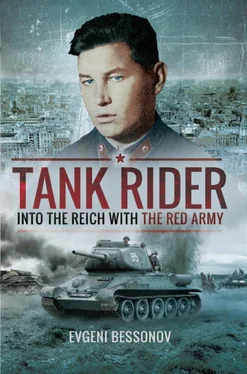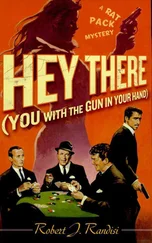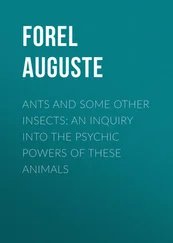
The war left such a tragic trace
And put so many men in graves
That after twenty, thirty years
Survivors don’t believe they live
K. SIMONOV
Map to show the Vistula-Oder operation, 12 January 1945 to 26 January 1945.
Our preparation for the upcoming battles on the Sandomir bridgehead was over. In late December, 1944, we marched on foot from the village where we had been staying, not far from the front line. Our battalion concentrated in a forest, and for several days we slept at campfires using branches of pine trees to sleep on. After that we built dugouts and installed stoves that we made from empty fuel barrels. Rain capes or pieces of tarpaulin served as doors for dugouts. Frost was not that heavy – 10 to 12 degrees – but we were freezing to our bones. Of course it was warmer in dugouts. We did not have any training during that period; we were given all our time for rest. We slept as much as we wanted, checked our weapons and did all kinds of small things – mostly we played cards and wrote letters home.
They took us officers to the front line several times. We went to the trenches to work out the routes of advance for tanks with tank riders. We also got to know the tank crews. We did not know when the grand offensive was to start – such things were kept secret. However, one could feel that the moment was coming, and this is why we were somewhat excited, even nervous. The two worst things are waiting for something and catching up with someone.
Finally, the big day, 12 January, 1945, came. After a long artillery preparation and air force strikes, infantry units of the front went over to the offensive and in a dashing assault captured the first and the second defence lines of the enemy. Artillery preparation and air force strikes lasted at least one-and-a-half hours, if I am not mistaken. Guns, including 76 mm to 152 mm, 82 mm, 120 mm and 160 mm mortars, as well as Katyushas firing on the enemy defences. Bombers and Il-2 Shturmoviks raided the defences as well. It was a permanent rumble; we even had to shout, as we could not hear each other. The enemy’s positions were covered with a thick cloud of smoke, some debris was flying in the air, and something was burning and exploding there. The enemy could only return sporadic fire, as almost all artillery and mortars were suppressed.
After the Field Army’s infantry units broke through the defences, our turn came. The task of our Brigade as well as the whole Tank Army was to enter the gap, develop the advance towards the Oder and then capture a bridgehead on its left, western bank.
Our company, just like the other companies of the battalion, moved forward in a column on tanks of the tank regiment. It was a total mess on the road, other combat units and all kinds of supply units were also on the move; some trucks and lorries moved against the main stream of vehicles, slowing down our offensive. It was dangerous to drive off the road – mines were all around, and engineers had not yet had time to clear them. M-1 emochka (loosely translates as ‘small M’ car – translator’s comment) car of the Brigade commander hit a mine and Colonel Turkin survived by pure luck (he got off with light shellshock), although his driver and the orderly were killed and the car was blown to pieces. Platoon leader Lieutenant Shakulo from our company was wounded on 12 January, he was hit by something that broke his leg. When he left for hospital, I was ordered to lead his platoon as well, although the acting platoon leader in his platoon was Sergeant Savkin – a wonderful guy, a brave and skilful soldier.
During the entire day of 12 January, 1945, we were advancing forward successfully, though slowly. Clouds were hanging low in the sky, and the enemy’s air force was not present. It grew dark early in January, and already at twilight we ran into the enemy’s stronghold in front of a village. The enemy opened fire from machine-guns and tank guns at point-blank range.
We quickly got off our tanks, deployed in a line and lay down on open terrain. We tried to dig in, but the battalion commander and tank regiment commander ordered us to attack. It was almost dark already, which suited us well – this meant fewer losses. As often happens in night action, the company split – Vyunov’s platoon attacked to the left, while I attacked on the right flank with my two platoons. Despite enemy fire, we rushed into the village and the enemy fled. Our tanks supported us by fire, but did not enter the village, staying where they were. Apparently, they were afraid of the Tigers positioned behind the village and firing intensively on our tanks. They did not fire at us, infantry, though, as they were afraid of hitting their own infantry that was fleeing through the village.
I went to the opposite side of the village with two platoons and occupied the German trenches. The Germans could no longer be seen. The night battle that followed stayed in my memory very well, as we had to repel German counterattacks till very dawn. I did not have communication with either the company commander or the platoon of Senior Lieutenant Vyunov; I did not even know where they were. Machine-gun platoon leader Alexander Guschenkov noticed the direction of my attack and, without losing his head in this hell, came to assist me with his two Maxim machine-guns and his men. He took up a position on the right flank of my two platoons, as my right flank was exposed. The other companies of the battalion covered the left flank, which were also in action. The third platoon of the company with its leader was also somewhere over there. Guschenkov’s machine-gun crews were a great help to us.
Fire ceased for some time and I decided to walk along the newly captured German trenches in order to support my men and show them that I was with them. This is important for soldiers, especially in a hard situation. Sergeant Savkin drew my attention to German hand grenades, mess tins, helmets and clips that were hidden in niches of trenches. I ordered my men not to touch them, but one soldier either forgot my order or just started jumping in order to get warm, and touched something. An explosion sounded in the air, the soldier was thrown 2 metres up in the air and he fell dead into the trench like an empty sack. That was the only casualty we had from boobytrap mines.
The Germans counter-attacked after some time, but only with infantry – their tanks stayed where they were. At that time our T-34s had already driven up to us, and together with them we repelled the attack. The German infantry fell back, while the German tanks opened fire on the village, setting some houses on fire. Combat at night is generally very hard, and this engagement lasted the whole night. You cannot see a thing; you only fire at flashes or barely visible shadows. In darkness you cannot see the results of your own fire and of course it is less effective than in daytime.
As far as I remember, there were at least thirteen to fifteen Tiger tanks, but I cannot say how many infantry they had – it was too dark. Just three T-34-85 tanks supported me. The tank crews were green and it was their first battle. They rarely fired on the German tanks, being afraid that the enemy would spot their muzzle flashes, and when the houses caught fire, they tried to retreat as far as possible into the dark shadow. Although they did not retreat far, their retreat had a bad effect on the morale of my soldiers, most of whom were also green, but even the old hands were scared. They held on with their last bit of strength, but kept on firing at the enemy. However, they were all looking back at our tanks – they were afraid that the tanks would just leave us and drive to the rear. So I had to run back and forth – first to the tanks in order to stop them, if they had retreated too far, bring them back or even ask them to fire, then run to see how Guschenkov was doing, and then back to my men. The whole village was on fire, shells were exploding all around, and bullets and shell splinters flew shrieking through the air. Our DP machine-guns and submachine-guns were firing. The Germans tried to attack our flank, but Guschenkov’s machine-guns cut them down almost at point-blank range and they ceased their attacks.
Читать дальше













